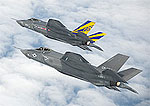Chiefs to Congress: Fiscal Crisis Threatens U.S. Military Edge
 WASHINGTON, Feb. 26, 2013 – America’s military superiority is founded on training and readiness, and the fiscal crisis facing the country threatens to strip away that edge, members of the Joint Chiefs of Staff told Congress today.
WASHINGTON, Feb. 26, 2013 – America’s military superiority is founded on training and readiness, and the fiscal crisis facing the country threatens to strip away that edge, members of the Joint Chiefs of Staff told Congress today.
Army Chief of Staff Gen. Ray Odierno, Chief of Naval Operations Adm. Jonathan W. Greenert, Marine Corps Commandant Gen. James F. Amos, Air Force Chief of Staff Gen. Mark A. Welsh III and National Guard Bureau Chief Army Gen. Frank J. Grass testified before the House Appropriations Committee’s defense subcommittee on fiscal challenges facing the department.
The chiefs discussed the effects of sequester - $47 billion in across-the-board 2013 defense spending cuts that will take effect March 1 if Congress doesn’t act –- and the continuing resolution, which guides government spending in the absence of an approved budget.
If the continuing resolution stays in place unchanged through the rest of the fiscal year, they said, the Army will see an $18 billion shortfall, and the Navy’s budget will be $8.6 billion in the red. And because a continuing resolution limits contracting, maintenance and construction, they noted, the workarounds they’ve adopted under it are creating even bigger problems for the future.
All five chiefs described cost-cutting measures they’ve already taken, and outlined likely short- and long-term consequences of continued budget uncertainty. All agreed the biggest danger to the force is that, as Odierno told subcommittee members, “these cuts will have grave consequences and immediate impact on the readiness of our remaining forces.”
Amos described the dilemma the Joint Chiefs face: to support warfighters and keep readiness high in units soon to deploy, the service leaders will have to strip funds from maintenance and operations accounts and furlough civilian employees without pay for up to 22 days through the Sept. 30 end of the fiscal year. This means that while ships and planes wait for maintenance and troops miss out on essential training, medical clinics, schools and counselors’ offices will reduce hours and services.
“We will curtail training for 80 percent of our ground forces,” Odierno said.
Amos said the cuts will harm the Marine Corps’ readiness. “By the beginning of next year,” he said, “more than 50 percent of my tactical units will be below acceptable levels of readiness for deployment to combat.”
Welsh said two-thirds of Air Force combat units will cut training starting in March. “They'll drop below acceptable readiness levels, by our definitions, by mid-May,” he added. “Most will be completely non-mission-capable as a unit by July.”
If a 2014 budget is in place by October, he said, it will take the Air Force six months to regain its present level of training.
The chiefs asked for Congress’ help in giving them some spending flexibility if the continuing resolution remains. Authority to move funds between accounts could help prevent the current unavoidable waste Greenert decried in the Navy. The shortfall created by the continuing resolution, he said, “has compelled us to cancel ship and aircraft maintenance, reduce operations, curtail training for forces that will soon deploy, and [notify] 186,000 of our civilians of a possible furlough.”
“We've lost $600 million in February because of … just lost opportunities,” the Navy’s top officer said. “Through the month of March, if we don't have that opportunity to reallocate funds, it would be another $1.2 billion, and it just continues to grow and cascade as we go through the summer.”
Greenert told the panel an appropriations bill for this fiscal year is necessary to allow the department to distribute resources in a deliberate manner.
Odierno said for more flexibility would be significant for the Army and “would help us eliminate the $6 billion shortfall we have in continuing resolution.”
“It would at least solve one-third of the problem that we have today,” he added.
The Army chief said he started his career in a hollow Army, and he doesn’t want to end it there.
“We simply cannot take the readiness of our force for granted,” he said. “If we do not have the resources to train and equip the force, our soldiers -- our young men and women - are the ones who will pay the price, potentially with their lives.”